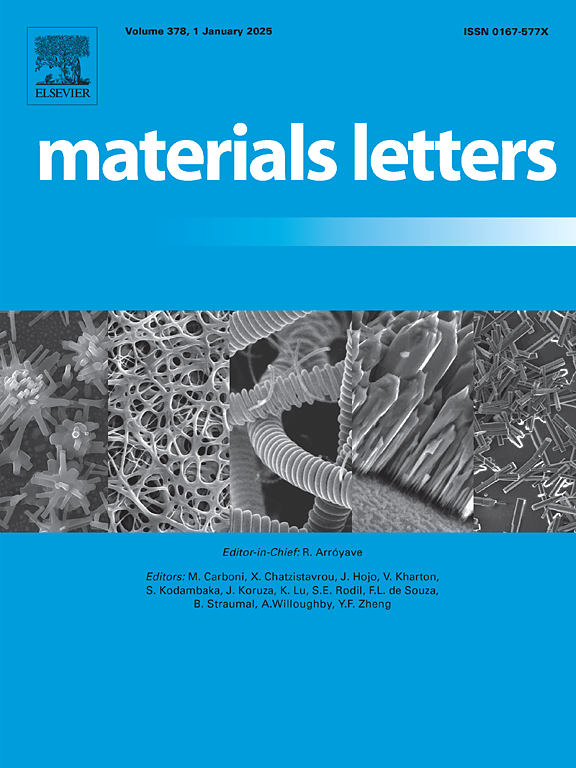超薄fe -金属有机骨架衍生Fe3O4全固态电池的制备:开发用于探测固体电解质/电极界面的测试平台
IF 2.7
4区 材料科学
Q3 MATERIALS SCIENCE, MULTIDISCIPLINARY
引用次数: 0
摘要
铁基金属有机框架(Fe-MOFs)与Li1.3Al0.3Ti1.7(PO4)3 (LATP)作为固体电解质的集成为高性能全固态电池(assb)的安全性和稳定性增强提供了一条有希望的途径。在这项研究中,我们报告了与LATP界面的超薄Fe-MOF阳极的制造和表征,利用电泳沉积(EPD)的优势来创建无添加剂且控制良好的薄层。这种结构允许直接分析固体电解质/电极界面,消除体电极效应,并能够集中研究对ASSB性能至关重要的界面现象。扩散控制行为的优势(b值为0.5,扩散系数为3.9 × 10−13 cm2/s)来自Fe3O4固有的体氧化还原活性,沉积膜的多孔性使离子有效扩散,以及与LATP电解质的强界面,有利于离子进入体中。这项工作不仅突出了Fe-MOF和LATP在ASSB应用中的潜力,而且为探索和优化固态电池接口建立了一个实验平台。本文章由计算机程序翻译,如有差异,请以英文原文为准。
Fabrication of ultrathin Fe-metal organic framework-derived Fe3O4 all solid state battery: Developing test platform for probing the solid electrolyte/electrode interface
The integration of iron-based metal–organic frameworks (Fe-MOFs) with Li1.3Al0.3Ti1.7(PO4)3 (LATP) as a solid electrolyte offers a promising pathway toward high-performance, all-solid-state batteries (ASSBs) with enhanced safety and stability. In this study, we report on the fabrication and characterization of an ultrathin Fe-MOF anode interfaced with LATP, leveraging the benefits of electrophoretic deposition (EPD) to create an additive-free and well-controlled thin layer. This architecture allows for direct analysis of the solid electrolyte/electrode interface, eliminating bulk electrode effects and enabling focused investigations of interfacial phenomena critical to ASSB performance. The dominance of diffusion-controlled behavior with a b value of 0.5 with a diffusion coefficient of 3.9 × 10−13 cm2/s arises from the intrinsic bulk redox activity of Fe3O4, the porous nature of the deposited film enabling effective ionic diffusion, and the strong interface with the LATP electrolyte, which facilitates ion transport into the bulk. This work not only highlights the potential of Fe-MOF and LATP in ASSB applications but also establishes an experimental platform for exploring and optimizing solid-state battery interfaces.
求助全文
通过发布文献求助,成功后即可免费获取论文全文。
去求助
来源期刊

Materials Letters
工程技术-材料科学:综合
CiteScore
5.60
自引率
3.30%
发文量
1948
审稿时长
50 days
期刊介绍:
Materials Letters has an open access mirror journal Materials Letters: X, sharing the same aims and scope, editorial team, submission system and rigorous peer review.
Materials Letters is dedicated to publishing novel, cutting edge reports of broad interest to the materials community. The journal provides a forum for materials scientists and engineers, physicists, and chemists to rapidly communicate on the most important topics in the field of materials.
Contributions include, but are not limited to, a variety of topics such as:
• Materials - Metals and alloys, amorphous solids, ceramics, composites, polymers, semiconductors
• Applications - Structural, opto-electronic, magnetic, medical, MEMS, sensors, smart
• Characterization - Analytical, microscopy, scanning probes, nanoscopic, optical, electrical, magnetic, acoustic, spectroscopic, diffraction
• Novel Materials - Micro and nanostructures (nanowires, nanotubes, nanoparticles), nanocomposites, thin films, superlattices, quantum dots.
• Processing - Crystal growth, thin film processing, sol-gel processing, mechanical processing, assembly, nanocrystalline processing.
• Properties - Mechanical, magnetic, optical, electrical, ferroelectric, thermal, interfacial, transport, thermodynamic
• Synthesis - Quenching, solid state, solidification, solution synthesis, vapor deposition, high pressure, explosive
 求助内容:
求助内容: 应助结果提醒方式:
应助结果提醒方式:


